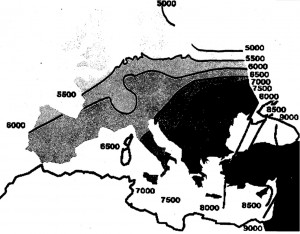From Early Knowledge Systems to Distributed Intelligence
The knowledge system projects described here are from my own professional journey. They are presented roughly in reverse chronological order. Most of the projects described here were done at PARC in the 1980’s and early 1990’s. The earlier Molgen project on experiment planning in molecular genetics was done at Stanford.
Knowledge systems arose in the artificial intelligence research community in the 1980’s as a reaction against earlier AI research that used game domains and artificial domains such as Blocks World, chess and logical puzzles. The earlier AI systems bet that search and clever inference would be the basis of intelligence and competence. In contrast, early knowledge system research challenged this approach by proclaiming that the crucial source of power was knowledge. Declaring that “knowledge is power” Ed Feigenbaum and others led a shift in AI research and practice towards approaches for capturing, representing, and using knowledge on practical, knowledge-intensive problems. Feigenbaum also led a wave of industrial investment in building AI systems that addressed real world problems.
Through the 1990s, knowledge systems were mostly stand-alone and handcrafted. AI systems gained knowledge when people updated them deliberately — either by programming in conventional computer languages or by using declarative representations in knowledge bases. Representation technology included frame-based representation languages for formal and semi-formal knowledge, Bayesian and logical languages and models, qualitative and quantitative reasoning. Modeling and simulation languages expanded the richness of representations that were employed. The fundamental work on representation and reasoning solidified foundations for what came next.
Today, knowledge systems are no longer stand-alone and knowledge bases are less often hand-crafted. Today’s online systems still depend on knowledge and employ knowledge representations. However, they are more often designed to gain knowledge through learning — either from explicit training examples or by mining data on the web. Furthermore, the “intelligence” of networked systems is shifting beyond independent and carefully-crafted knowledge bases. Increasingly, intelligence arises from interactions with other systems and people on the network. When people use social networks or vote on “likes” or preferences in the network, their activities and collaborations contribute to the fabric of a “smart network” yielding better search results, better recommendations, and over time, higher expectations of intelligence when we use online systems.
The future of intelligent online systems is being created by people who are designing robust human-computer interfaces, social media, mechanical Turk systems, and data-mining systems — concepts that existed in much more primitive forms in the 1980’s. Looking ahead, knowledge systems will increasingly infer knowledge using data from sensors.
The Knowledge Systems Book
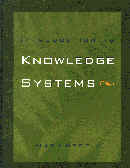 I entered AI as a researcher at the beginning of the field of expert systems. Drawn to the exciting possibility of creating knowledge systems with impact, I was also concerned that there was a widespread and overly-simplistic understanding of the limitations of the science and the art.
I entered AI as a researcher at the beginning of the field of expert systems. Drawn to the exciting possibility of creating knowledge systems with impact, I was also concerned that there was a widespread and overly-simplistic understanding of the limitations of the science and the art.
In the early 1990s I taught a course at Stanford University in order to develop a text book that would present the foundations and practice of the state-of-the-art of knowledge systems. The book blended an engineering perspective and a scientific/philosophical perspective. The knowledge systems research at Stanford was characteristically a blending of these perspectives. The engineering perspective is about the practice of building expert systems, including programming, knowledge representation, search, and specialized kids of reasoning. The scientific and philosophical perspectives sought foundations about knowledge and representation, semantics, the social construction of knowledge, and related matters.
The book is more interdisciplinary than was typical of the expert system literature at that time. The informal parts of the book included speculative thinking about reframing knowledge in terms of services in the network. Although those ideas were too radical and vague to be included in a course on computer science at the time, they were inspiring enough for me to include them in a “flame” paper on “the next knowledge medium.”
Reflections on a Knowledge Medium
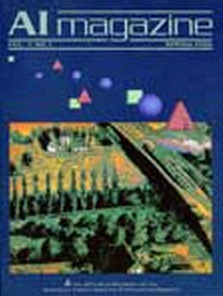 In 1985 I was invited by Stephen Cross to give a keynote address at a conference on Aerospace Applications of Artificial Intelligence. The corresponding paper, The Next Knowledge Medium, was later published in AI Magazine (cover left) and has been republished elsewhere.
In 1985 I was invited by Stephen Cross to give a keynote address at a conference on Aerospace Applications of Artificial Intelligence. The corresponding paper, The Next Knowledge Medium, was later published in AI Magazine (cover left) and has been republished elsewhere.
An introductory excerpt follows:
The article is in three parts: stories, models, and predictions. The stories describe processes of cultural change that have been studied by historians and anthropologists. They provide a historical context for considering present and future cultural changes. To illuminate these stories and their lessons about technology, several models of systems drawn from the sciences are considered. The models provide analogies and metaphors for making predictions.
Predictions are then made, drawing on some projects and ideas that might point the way to building a new knowledge medium — an information network with semi-automated services for the generation, distribution, and consumption of knowledge.
I include here several more general and speculative papers from this time that consider a larger vision of the potential of knowledge systems.
Stefik, M. & Conway, L. (1982) Towards the principled engineering of knowledge. AI Magazine, Vol. 3:3, pp. 4-16, Summer 1982. (Reprinted in Readings From the AI Magazine, Volumes 1-5, 1980-1985, pp. 135-147, 1988.)
Stefik, M., Aikins, J., Balzer, R., Benoit, J., Birnbaum, L., Hayes-Roth, F., Sacerdoti, E. (1982) The organization of expert systems: A tutorial. Artificial Intelligence, 18:2, 1982. (This paper was also printed as two chapters in Hayes-Roth, F., Waterman, D., and Lenat, D., Building Expert Systems, Addison-Wesley, 1983. This paper was translated to Russian in O.B. Lupanova (ed.), Cybernetic Collection, New series 22, Mir, Moscow, 1985. It was also translated into Chinese.)
Stefik, M. (1986) The next knowledge medium. AI Magazine, 7:1, pp. 34-46, Spring 1986. (Reprinted in Huberman, B.A. (ed) The Ecology of Computation, Amsterdam, The Netherlands: North Holland Publishing Co., 1988, pp. 315-342. An earlier version of this appeared in M.I. News, 10, pp. 55-66, Autumn 1985, a publication of the Turing Institute. Also revised and reprinted in Stefik, Mark. The Internet Edge, Cambridge, Ma.: The MIT Press,1999.)
Bobrow, D.G., Mittal, S., and Stefik, M.J. (1986) Expert systems: perils and promise. Communications of the ACM, 29:9, pp. 880-894, September 1986.
Bobrow, D.G., and Stefik, M. J. (1986) Perspectives on artificial intelligence programming. Science 231:4741, pp. 951-956, 28 February 1986. (Reprinted in Rich, C. & Waters R.C. (Eds.) Readings in Artificial Intelligence and Software Engineering, pp. 581-587, Los Altos,Ca.: Morgan Kaufman Publishers, 1986.)
Bobrow, D.G., and Stefik, M.J., (1987) Searching beyond reason: A response to McDermott’s “Critique of Pure Reason.” Computational Intelligence 3:3, pp. 162-165, August 1987.
Knowledge-Based Design Projects at PARC
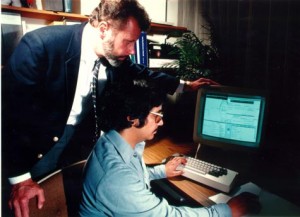 Several knowledge-based systems projects were done at PARC in the 1980’s when I led the Knowledge Systems Area. These included the KBVLSI project that was done jointly with Stanford University and included Chris Tong’s doctoral dissertation. Another dissertation was Cris Garcia’s research on design rationale in the Civil Engineering program at Stanford.
Several knowledge-based systems projects were done at PARC in the 1980’s when I led the Knowledge Systems Area. These included the KBVLSI project that was done jointly with Stanford University and included Chris Tong’s doctoral dissertation. Another dissertation was Cris Garcia’s research on design rationale in the Civil Engineering program at Stanford.
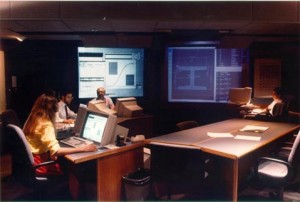 Sanjay Mittal did pioneering research on constraint reasoning in design and configuration, notably on the PRIDE system which designed paper paths for Xerox copiers. He is shown on the right with Clive Dym, a professor of mechanical engineering who spent a sabbatical at PARC working with us. PRIDE was developed in collaboration with Maurice Holmes’ group in the Xerox Design Center in Webster, New York.
Sanjay Mittal did pioneering research on constraint reasoning in design and configuration, notably on the PRIDE system which designed paper paths for Xerox copiers. He is shown on the right with Clive Dym, a professor of mechanical engineering who spent a sabbatical at PARC working with us. PRIDE was developed in collaboration with Maurice Holmes’ group in the Xerox Design Center in Webster, New York.
Above is a second colab or collabborative design environment, built in Webster, combining elements of our knowledge systems and collaboration research.
Blank, T., Stefik, M., vanCleemput, W. (1981) A parallel bit map processor architecture for DA Aalgorithms, 18th Conference on Design Automation, June 29-31, 1981.
Stefik, M. Bobrow, D.G. (1981) Linked Module Abstraction: A methodology for designing the architectures of digital systems. Knowledge-Based VLSI Design Group Memo KB-VLSI-81-9 (working paper), June 1981.
Stefik, M., Bobrow, D. G., Bell, A., Brown, H., Conway, L., Tong, C. (1981) The partitioning of concerns in digital system design. Proceedings of the Conference on Advanced Research in VLSI, Massachusetts Institute of Technology, Artech House, January 1982. (Also Xerox report VLSI-81-3, pp. 43-52, December 1981.)
Stefik, M. J. and de Kleer, J. (1983) Prospects for expert systems in CAD. Computer Design. pp. 65-76, April 21, 1983.
Garcia, A.C.B., Howard, H.G., Stefik, M.J. (1994) Improving design and documentation by using partially automated synthesis. AI EDAM. Vol. 8(4), 1994.
Commentary
S
tefik, M.J., (1985) Strategic Computing at DARPA: Overview and Assessment. Communications of the ACM, Vol 28, Number 7. Pages 690-704.

